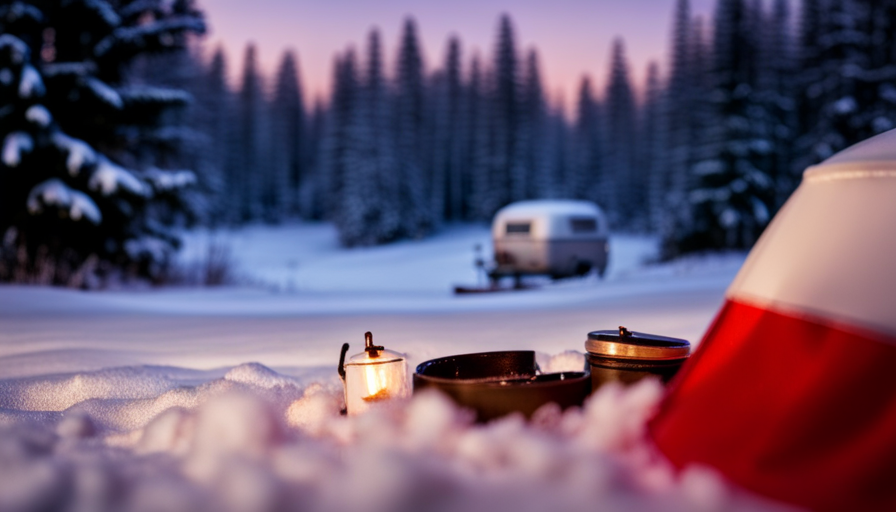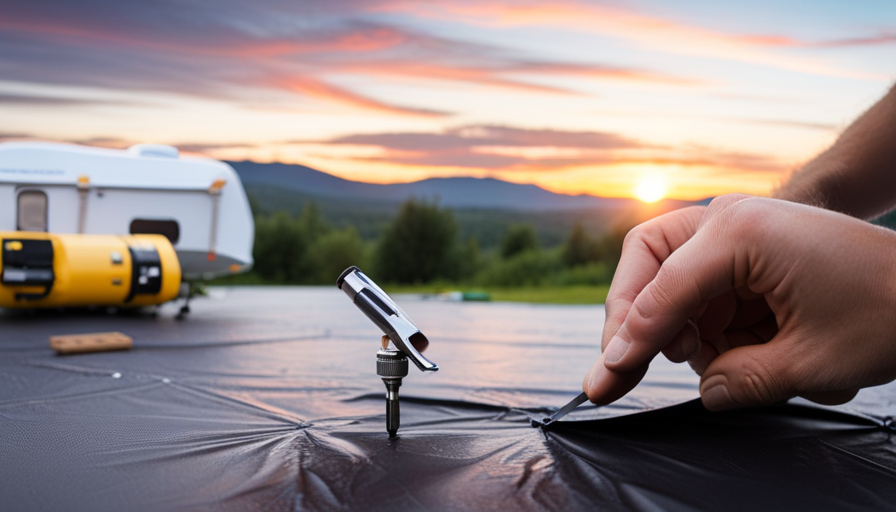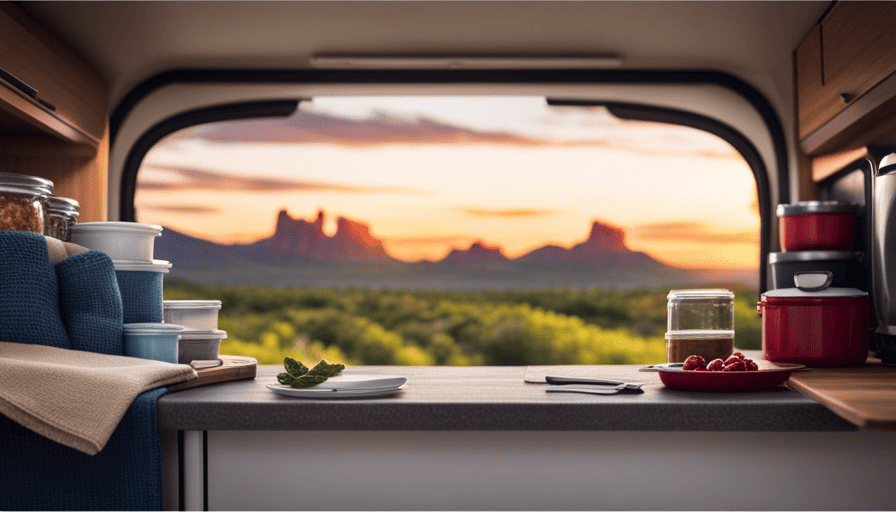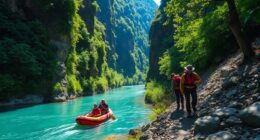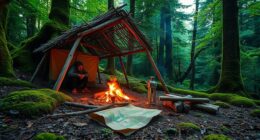Camping in the winter can be an exciting adventure, with breathtaking views and invigorating outdoor activities. But it can also be tough if you’re not ready. That’s where we can help, providing detailed tips on using a camper in the winter months.
Picture yourself nestled in a cozy camper, surrounded by a winter wonderland. It’s a scene straight out of a holiday movie, right? Well, with the right knowledge and a few essential tips, you can turn that picturesque dream into a reality.
From insulating your camper to choosing the right heating options, winterizing your water system, and packing appropriate clothing and gear, we’ve got you covered. We’ll also help you plan for potential weather challenges, cook warm and hearty meals, stay active and keep warm, be mindful of safety precautions, and most importantly, appreciate the unique beauty of winter camping.
So, let’s bundle up and embark on an unforgettable winter camping experience!
Key Takeaways
- Properly insulate the camper to create a comfortable and energy-efficient living space.
- Choose the right heating option for the camper, such as portable heaters or wood-burning stoves, while ensuring proper ventilation and safety measures.
- Winterize the water system by draining all water, adding antifreeze, insulating pipes, and using heated water hoses.
- Prepare appropriate clothing and gear for winter camping, including layering clothing, insulated boots, and essential camping equipment.
Insulate Your Camper Properly
To keep warm during the winter months, you’ll want to make sure you insulate your camper properly. Insulating your camper is crucial for creating a comfortable and energy-efficient living space.
There are several insulating techniques you can employ to ensure maximum heat retention. First, start by sealing any gaps or cracks in the walls, windows, and doors. This will prevent cold air from seeping in and warm air from escaping.
Next, consider adding insulation to the walls, roof, and floor of your camper. Materials such as foam board, fiberglass, or spray foam can be used to effectively trap heat inside. Additionally, using thermal curtains or reflective window coverings can help to further insulate your camper.
Remember to pay attention to the areas where heat is most likely to escape, such as vents, pipes, and skylights. Insulating these areas will prevent heat loss and keep your camper warm. It’s also important to insulate the underside of your camper to prevent cold air from entering through the floor.
By properly insulating your camper, you can create a cozy and energy-efficient living space that’ll keep you warm throughout the winter months. In the next section, we’ll discuss how to choose the right heating options for your camper without compromising safety and efficiency.
Choose the Right Heating Options
Stay cozy and warm in your camper during those chilly winter nights by selecting the perfect heating options. When it comes to heating your camper in the winter, portable heaters are a popular choice. These heaters are compact and easy to move around, allowing you to heat specific areas of your camper as needed. Look for models with adjustable settings and safety features such as automatic shut-off in case of tipping over or overheating.
Additionally, consider alternative heating methods such as propane heaters or wood-burning stoves. These options provide a more traditional and cozy feel, but make sure to follow safety guidelines and have proper ventilation to prevent carbon monoxide buildup. Propane heaters are efficient and can provide a consistent heat source for your camper. They’re easy to use and can be fueled by small propane tanks, making them convenient for camping trips. Wood-burning stoves, on the other hand, offer a rustic charm and the ability to cook meals while keeping warm. However, they require more maintenance and safety precautions, such as proper ventilation and regular cleaning.
Transitioning into the next section about winterizing your water system, it’s important to remember that heating your camper is just one aspect of staying comfortable during the winter months. Now, let’s explore how to ensure your water system stays functional in the cold temperatures.
Winterize Your Water System
Ensuring your water system doesn’t freeze over is like protecting a delicate flower from the harsh winter frost. Winterizing pipes and preventing freezing is crucial for a successful winter camping experience.
When the temperature drops, water left in your camper’s pipes can freeze and cause serious damage. To prevent this, start by draining all the water from your tanks and pipes. Open all the faucets and let the water flow out completely.
Next, add non-toxic RV antifreeze to the water system. This will prevent any remaining water from freezing and expanding, which could lead to burst pipes. Make sure to follow the manufacturer’s instructions when using antifreeze.
Additionally, insulate any exposed pipes with foam pipe insulation or heat tape. This will provide an extra layer of protection against freezing temperatures.
Lastly, consider using heated water hoses to prevent the water from freezing before it even enters your camper. By taking these steps to winterize your water system, you can avoid costly repairs and ensure a smooth camping experience in the winter.
Now, let’s transition into the next section about packing appropriate clothing and gear.
Pack Appropriate Clothing and Gear
Before embarking on your winter camping adventure, make sure to pack the necessary clothing and gear to stay warm and comfortable in chilly temperatures.
When it comes to clothing essentials, layering is key. Start with a moisture-wicking base layer that’ll keep sweat away from your body. Add a thermal mid-layer for insulation and a waterproof outer layer to protect you from wind and snow. Don’t forget to pack extra pairs of socks and gloves, as they tend to get wet easily. A good pair of insulated boots is essential to keep your feet warm and dry.
In addition to clothing, it’s important to have the right gear checklist. A four-season tent is a must-have, as it’s designed to withstand harsh winter conditions. A warm sleeping bag with a low temperature rating will ensure a cozy night’s sleep. Don’t forget to pack a sleeping pad for insulation from the cold ground. A portable stove and fuel are essential for cooking hot meals and drinks. It’s also important to have a reliable headlamp and extra batteries, as daylight is limited during winter.
Now that you’ve packed your clothing and gear, it’s time to plan for potential weather challenges.
Plan for Potential Weather Challenges
Prepare yourself for the unpredictable and often treacherous winter weather by bringing along all the gear necessary to conquer Mother Nature’s wrath. Dressing in layers is essential for staying warm in frigid temperatures. Start with a moisture-wicking base layer to keep sweat away from your body. Add an insulating layer, such as a fleece or down jacket, to trap heat. Finally, top it off with a waterproof and windproof outer layer to protect against the elements. Don’t forget to pack hats, gloves, scarves, and warm socks to keep extremities cozy.
In addition to layering clothing, using alternative heating sources can make a significant difference in your comfort level. Portable propane heaters are a popular choice for campers, as they provide a steady source of heat. Just make sure to use them in a well-ventilated area and follow safety precautions. Electric blankets or heated mattress pads can also keep you warm during the night.
Transitioning into the subsequent section about setting up a warm and cozy sleeping space, it’s important to create a comfortable environment where you can rest and restore your energy for the next day’s adventures.
Set Up a Warm and Cozy Sleeping Space
As you settle in for the night, get ready to transform your sleeping space into a snug sanctuary where you can escape from the chill and drift off into dreamland. When camping in the winter, it’s crucial to maintain a comfortable temperature inside your camper. Here are some tips to keep you warm and cozy throughout the night:
-
Insulate your camper: Use foam insulation or thermal curtains to prevent cold air from seeping in and heat from escaping.
-
Use an electric heater: Invest in a portable electric heater with built-in safety features to regulate the temperature inside your camper.
-
Layer your bedding: Opt for cozy bedding options such as flannel sheets, thermal blankets, and a down comforter to trap heat and keep you warm.
-
Use hot water bottles: Fill up hot water bottles and place them near your feet or under your blankets to provide extra warmth.
-
Wear thermal clothing: Dress in layers and wear thermal underwear, socks, and a hat to keep your body insulated.
By following these tips, you can create a warm and comfortable sleeping space in your camper.
Now, let’s move on to the next section and learn how to cook warm and hearty meals to keep you fueled during your winter camping adventures.
Cook Warm and Hearty Meals
Get ready to indulge in delicious, warm, and hearty meals that’ll keep us fueled and satisfied during our winter camping adventures. Cooking warm and hearty meals is essential for staying cozy and maintaining our energy levels in the cold weather.
When it comes to hearty winter recipes, there are plenty of options to choose from. One of our favorites is a hearty beef stew, packed with tender chunks of beef, root vegetables, and flavorful herbs and spices. Another great option is a creamy chicken and wild rice soup, which isn’t only delicious but also keeps us warm from the inside out.
To make these meals, it’s important to have the right equipment. A good quality camping stove or portable grill is a must-have for cooking in the winter. It’s also helpful to invest in a sturdy Dutch oven or cast iron skillet, as they distribute heat evenly and can withstand the cold temperatures. Additionally, having a well-insulated cooler or portable fridge will ensure that our ingredients stay fresh and safe to eat.
When cooking in the winter, there are a few tips to keep in mind. Prepping ingredients in advance can save time and keep our fingers from getting too cold. It’s also important to cook in a well-ventilated area to avoid any buildup of carbon monoxide. Lastly, using warm spices like cinnamon, nutmeg, and cloves can add a comforting touch to our meals.
With our bellies full of warm and hearty meals, we’ll be ready to stay active and keep warm during our winter camping escapades.
Stay Active and Keep Warm
Stay warm and active during your winter camping adventures by bundling up in cozy layers and taking brisk walks through the snow-covered trails.
Winter hiking trails offer a unique and breathtaking experience, allowing you to immerse yourself in the beauty of nature while getting your blood pumping. Make sure you have proper winter gear, such as insulated boots, thermal socks, and waterproof gloves, to keep yourself protected from the cold.
In addition to outdoor activities, there are plenty of indoor winter activities to enjoy in your camper. Set up a cozy space inside with warm blankets, a portable heater, and a board game or two. You can also bring along a collection of your favorite books or movies to pass the time. Cooking warm and hearty meals can also be an enjoyable indoor activity, allowing you to experiment with new recipes and keep your belly full and satisfied.
As you engage in these activities, it’s important to be mindful of safety precautions. Ensure that you’re properly dressed for the weather and that you have a first aid kit on hand. Be aware of any potential hazards on the winter hiking trails, such as icy patches or uneven terrain.
By staying active and warm while being mindful of safety precautions, you can make the most of your winter camping experience.
Be Mindful of Safety Precautions
Make sure to keep an eye out for any potential hazards on the winter hiking trails, as they can be as treacherous as a hidden ice patch on a frozen lake. When it comes to winter camping, staying safe is crucial.
Before embarking on your winter adventure, it’s important to have the right winter camping gear and be aware of winter camping safety precautions.
First and foremost, investing in proper winter camping gear is essential. Make sure to have a four-season tent that can withstand the harsh winter conditions. Insulated sleeping bags, thermal clothing, and waterproof boots are also must-haves. These items will keep you warm and protected from the cold elements.
Additionally, it’s important to be mindful of winter camping safety. Always check the weather forecast before heading out and bring extra layers in case of sudden changes. Be cautious of hypothermia and frostbite by staying dry and avoiding prolonged exposure to extreme cold. Keep a first aid kit handy and know how to use it in case of emergencies.
With the right gear and safety precautions, winter camping can be a truly enjoyable experience. You’ll have the opportunity to witness the unique beauty of winter camping, from snow-covered landscapes to starry night skies.
So, pack your gear, stay safe, and embrace the wonders of winter camping.
Enjoy the Unique Beauty of Winter Camping
Immersing yourself in the serene winter landscape, you’ll be captivated by the ethereal beauty of a snow-covered campground. Winter camping offers a unique opportunity to experience nature in a whole new way.
Here are some winter camping activities and tips for staying warm:
-
Embrace the outdoors: Engage in winter activities like snowshoeing, cross-country skiing, or ice fishing. These activities not only keep you active but also allow you to fully appreciate the winter wonderland around you.
-
Layer up: Dressing in layers is crucial for staying warm. Start with a moisture-wicking base layer, add insulating layers, and finish with a waterproof outer layer. Don’t forget to wear warm socks, gloves, and a hat to protect your extremities.
-
Stay cozy at night: Invest in a high-quality sleeping bag with a low-temperature rating to ensure a warm and comfortable night’s sleep. Use a sleeping pad or air mattress to provide insulation from the cold ground.
-
Keep the camper warm: Use an electric or propane heater to warm up the camper. Make sure to follow safety guidelines and never leave the heater unattended. Insulate windows and doors with thermal curtains or weatherstripping to prevent drafts.
By following these tips and engaging in winter camping activities, you can fully enjoy the beauty of winter while staying warm and comfortable in your camper. Happy winter camping!
Frequently Asked Questions
Can I use my regular camping gear in the winter or do I need specific winter gear?
In order to stay warm and comfortable during winter camping, it’s important to have specific winter gear. Regular camping gear may not provide enough insulation to keep you warm in colder temperatures. Consider investing in a camper with good insulation, as it’ll help maintain a comfortable temperature inside.
Additionally, winter sleeping bags are designed to provide extra warmth and insulation, making them essential for cold weather camping.
How can I prevent condensation from forming inside the camper?
To prevent condensation inside the camper during winter, proper insulation is key. Make sure all windows and doors are sealed tightly to minimize the entry of cold air. Use insulated curtains or window coverings to further reduce heat loss.
Consider adding insulation to the walls and floors of the camper to maintain a comfortable temperature. Ventilation is also crucial to prevent condensation buildup, so use roof vents or crack windows slightly.
What should I do if I encounter a winter storm while camping?
If you encounter a winter storm while camping, winter storm preparation is crucial. Make sure to have essential items for winter camping, such as a reliable emergency kit, warm clothing, extra blankets, and a portable heater.
It’s also important to monitor weather forecasts and be prepared to seek shelter if necessary. Stay safe by avoiding unnecessary travel and staying inside your camper until the storm passes.
Is it safe to use a propane heater inside the camper?
Using a propane heater inside a camper can be dangerous. It’s like playing with fire in a dry forest; the risk of carbon monoxide poisoning and fire is high. Instead, consider safer alternatives for heating your camper in winter. Use a properly vented propane heater outside, or invest in electric heaters or a wood-burning stove. These options provide warmth without the same risks. Prioritize safety to enjoy a cozy winter camping experience.
How do I prevent my water system from freezing in extremely cold temperatures?
To prevent frozen pipes and insulate the water system in extremely cold temperatures, we take several precautions.
Firstly, we wrap heat tape around exposed pipes and insulate them with foam pipe insulation.
Additionally, we use a heated hose or heat tape on the water hose to ensure water flows smoothly.
Inside the camper, we open cabinet doors to allow warm air to circulate around the plumbing.
Lastly, we use a space heater to maintain a consistent temperature inside the camper.
What Steps Should I Take to Use My Camper in the Winter?
When winterizing camper for living, start by insulating windows and doors to keep warm air in. Use a skirt around the base of the camper to block cold air. Install a heated water hose to prevent freezing. Keep a space heater inside for extra warmth, and use propane sparingly for safety.
Conclusion
In conclusion, winter camping in a camper can be a thrilling and rewarding experience. By following the steps outlined in this article, we’ve learned how to properly insulate our camper, choose the right heating options, winterize our water system, pack appropriate clothing and gear, plan for potential weather challenges, cook warm and hearty meals, stay active and keep warm, be mindful of safety precautions, and enjoy the unique beauty of winter camping.
As the saying goes, "There’s no such thing as bad weather, only inappropriate clothing." So, bundle up and embrace the winter wonderland in your camper!

